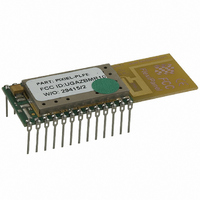PIXLITE-DIL-PLFE Flexipanel, PIXLITE-DIL-PLFE Datasheet - Page 5

PIXLITE-DIL-PLFE
Manufacturer Part Number
PIXLITE-DIL-PLFE
Description
MODULE ZIGBEE SW FAST 24-DIP
Manufacturer
Flexipanel
Series
Pixie™r
Specifications of PIXLITE-DIL-PLFE
Frequency
2.4GHz
Modulation Or Protocol
802.15.4 Zigbee
Power - Output
0dBm
Voltage - Supply
2.1 V ~ 3.6 V
Current - Receiving
25mA
Current - Transmitting
25mA
Data Interface
PCB, Through Hole
Memory Size
32kB ROM, 1536B RAM
Antenna Connector
On-Board, Trace
Operating Temperature
-40°C ~ 85°C
Package / Case
24-DIP Module
Lead Free Status / RoHS Status
Lead free / RoHS Compliant
Applications
-
Sensitivity
-
Data Rate - Maximum
-
Other names
658-1006-5
PIXIE-LITE-PLFE
PIXIE-LITE-PLFE
Pixie Lite
Pixie is an EasyBee with a low-end PIC
microcontroller added. It is the optimum solution
for IEEE 802.15.4 devices and reduced function
ZigBee devices. It costs about 20% less than the
Pixie.
UZBee
UZBee is an EasyBee with a USB-enabled PIC
microcontroller added and housed in a USB
adapter casing, complete with USB plug. It has
roughly the same capabilities as Pixie Lite, plus
the USB service.
gateways to PCs and from there to the internet. It
also makes a nice packet sniffer application.
The current UZBee does not have enough memory
to be a ZigBee coordinator or MailBox device.
We’re working on that.
LinkMatik
LinkMatik is a Bluetooth transceiver capable of
supporting SPP (with up to 4 connections), SCO,
DUN and OPP profiles.
controlled using a command interface. It is also
possible to configure it so it can operate as a
single-connection transparent serial device; indeed
this is the configuration in which it is shipped.
Toothpick
The LinkMatik is a powerful radio but it lacks
programmability.
combining it with a PIC 18LF6722 microcontroller,
which has many interfaces such as SPI, serial, A/D
and PWM. It also contains a Remote Client user
interface server, making it a powerful tool for
developing autonomous Bluetooth applications.
Various off-the-shelf firmware options are available
for Toothpick.
acquisition and remote control and are ideal for
one-off sensor and control applications.
Communications Modes
The more ambitions a radio communications
network gets, the harder it gets to specify who is to
be talking to whom.
avoiding the need to specify a recipient where
possible. This allows ‘transparent’ interfaces to be
developed, where only data transferred between
the application and the transceiver; commands are
not required.
Page 5
2-Feb-07
Most are focused on data
Toothpick addresses this by
It is an ideal solution for
Some effort goes into
These profiles are
RF Transceiver Selection Guide DS500-1
Slave
Slaves communicate with one other device only
Depending on the implementation, that might be:
Slaves are useful for implementing simple devices
in a multi-device network, since the slave does not
need to decide who to send messages to.
Broadcast
Broadcast devices transmit data simultaneously to
all devices in a multi-device network. No recipient
address needs to be specified. Any addressing
issues must be solved at the application level.
This is useful for working with legacy systems, for
example RS485 cable replacement systems. It is,
however, rather wasteful of resources in multi-hop
systems if most applications are going to ignore
most messages.
Generally,
acknowledged. This would normally be done at
the application level.
Addressed
Addressed communications are directed towards
specific devices.
communications, the network will determine the
appropriate route to the destination.
Addressing adds a lot of complication. It is not
really
applications interface if an address needs to be
specified.
need to be specified, but because devices need to
work out which address belongs to which device.
The MailBox application goes some way to
address this by assigning addresses according to
the function that a device performs rather than
according to its location within a network.
Power Management
The radio receivers on these devices are very
sophisticated in order to maximize reception
quality. The drawback is they consume as much
• the master or coordinator
• a parent router
• the last device to send a message to it
• as instructed by another device (redirecting)
• as dictated by non-volatile ROM settings
• as dictated by I/O settings
(mirroring)
possible
This is not just because addresses
broadcast
© FlexiPanel Ltd
to
In the case of multi-hop
implement
messages
a
www.FlexiPanel.com
transparent
are
not






















